by Prudence Caskey | Jan 22, 2019
Imagine this…an appointment runs long, you skip lunch and end up snacking the rest of the day. That leads to eating dinner very late and you feeling like your whole diet and commitment to eating better in 2019 is blown! Don’t toss in the towel and give up; each new morning brings a new day and a fresh start and a chance to start over.
One of the most important skills youth learn and practice in 4-H is goal setting behavior. Here are some ways to help make goals more achievable for you and the youth in your life:
-
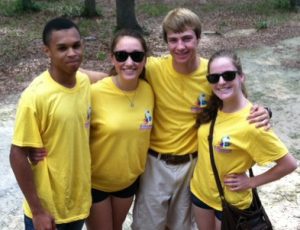
Youth are most motivated when they set their own goals.
Make goals S.M.A.R.T.
- Goals should be Specific, Measurable, Achievable, Realistic and Tangible
- Develop an Action Plan
- Write goals down
- Have an action plan to track progress
- Reflect along the way
- Make your goals present in your daily activities
- Put a reminder note on your mirror
- Set a reminder alarm on your phone
- Get an accountability partner
- Find someone you can trust to report your progress
- Check in an chat

Nothing matches the look on a face when a goal is reached!
My son is my physical activity accountability partner, and he and I walk together. Sometimes he has to drag me out of the house, and sometimes I have to get him motivated to go – whatever it takes to meet your goals.
Remember, every day is new with the opportunity to start fresh each day. Make a New Day Resolution to achieve your goals. If you fell off the wagon yesterday, let it go. Best wishes for a great new year and for every new day you have!
For more information on 4-H in your county, contact your local UF/IFAS Extension office.
Resources: How Setting Goals Helps Teens Succeed
by Niki Crawson | Oct 26, 2018
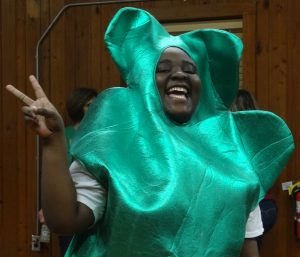
A happy 4-H member’s smile is contagious in this face-friendly clover costume.
While Walmart has already jumped to Christmas season, many parents are still scrambling to figure out their children’s costume for October’s Halloween party. Now, all of us have the cutest pumpkins in the pumpkin patch, but none of our children want to dress up as pumpkins anymore! Gone are the simple days of our generation when white sheets with eye holes were the extent of our Halloween attire.
With the hectic schedule of the world and the complicated costumes of today, here are a few guidelines to follow when helping children choose Halloween costumes (and keep them safe safety during the spooktacular holiday season).

This little pumpkin has comfortable walking shoes for trick or treating.
If it Fits, it Flies Past Inspection
While cute or scary may be what the children are striving for, well-fitting costumes should be the goal for all parents. Ill-fighting costumes are a disaster waiting to happen. Costumes that hang loosely become a distraction. Capes, gowns, or any material in length that drags the ground can be a tricky thing to maneuver at any age so be sure to trim above the ankle. Speaking of ankles, shoes that are too high can cause unexpected hospital visits so keep shoes low to the ground and comfortable to walk in. Children (and parents) do a lot of walking to collect their candy treats. Shoes that are too large or too small can cause blisters and cranky children, all things to avoid on a fun night.
Can You See Me Now?
One of the scariest things about Halloween is not what you can see but what you can’t see! Not being able to see children in costume in poorly lit areas of the neighborhood can be scary for adults. Parents, remedy this by using inexpensive reflective paint or tape to make children’s costumes visible or giving them glowsticks to wear or flashlights to hold.
Be sure to think about if your children can see well in their costumes. Masks can be difficult to wear if they don’t fit well. Be sure that eye and breathing holes are extra-large. If a costume can be complete without a mask, consider skipping it and use makeup. If costumes are come with hats, scarves, or capes, secure them down with velcro to keep from hitting others.
Does my Makeup Look OK?
Children love face paint and makeup, and hair dye appears to be the latest trend. Halloween seems a good fit for these outlets, but use them with caution. More and more children are sensitive to pigments found in everyday items – makeup included. Your children may be going for the spooky look but not at the risk of it being itchy and painful. If your children will be using face paint, makeup and/or hair dye, do a simple test run at least a week before use to ensure there are no allergies to the ingredients.
Accessorize Everything…Or Not
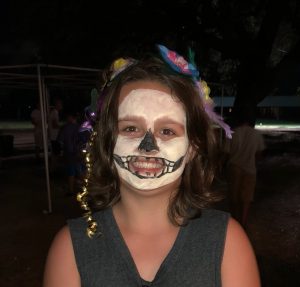
Makeup that does not obstruct children’s view is essential to their safety.
You’ve probably heard that “accessories make the outfit,” but in the case of Halloween and children, accessories can be highly overrated. Parents usually end up carrying the accessories that went with their children’s costumes before the night is over. But if children insist their outfits are not complete without a Ninja sword or Katniss Everdeen’s bow and arrow, be sure they are easily distinguished toys. Those accessories should be soft and flexible.
Spooktacular Adventure Awaits!
Whether you get into Halloween with costumes or not, these tips are good reminders for all of us to look out for children and keep them safe. Enjoy the upcoming holiday seasons!
To find out more information about 4-H programs that can offer essential life skills to your children or to volunteer your time to work with children in your area, please contact your local UF/IFAS County Extension Office, or visit http://florida4h.org.
by Julie Pigott Dillard | Oct 1, 2018
2018 4-H Chick Chain
The final link in the 4-H Chick Chain project closed on Saturday as 4-H members from the northwest extension district participated in a showmanship and skill-a-thon contest and brought their best birds for judging.

Skill-a-Thon Seniors

Skill-a-Thon Juniors

Skill-a-Thon Intermediates
Showmanship – This tests youth on how knowledgeable they are about the care, nutrition and health of their project and how they handle their bird.
Junior Showmanship – 1st Taylor Anderson,
2nd Tucker Padgett, 3rd Emma Weeks
Intermediate Showmanship – 1st Catherine Proud, 2nd David Marr, 3rd Brodie Price
Senior Showmanship – 1st Kearsten Dalton, 2nd Hailey Dalton, 3rd Brayden Price

Best of Breed winners
Exhibition – How the youth fed and cared for their projects was also put to the test as the birds were judged on breed characteristics and production potential.
Best of Breed Barred Rock – JaceBryan Broxson
Best of Breed Buff Orpington – Ethan Thornburry
Best of Breed Cochin – Brooks Marr
Best of Breed Cuckoo Maran – Kearsten Dalton
Best of Breed Speckled Sussex – Emma Fore
Best of Breed White Leghorn – Bella Price

Overall Grand Champion and Reserve Champion
Grand and Reserve Champions
From the Best of Breed winners, an overall grand champion and reserve champion were named.
Overall Reserve Champion – Emma Fore
Overall Grand Champion – Bella Price

Best of Show Production Bird
Best of Show Production
Youth who have participated in the 4-H Chick Chain in 2016 and 2017 also brought their best production birds to be judged. Birds were judged on production elements.
Best of Show Production – Brayden Price
Skill-A-Thon

Skill-a-Thon Juniors

Skill-a-Thon Intermediates

Skill-a-Thon Seniors
Skill-a-thon is a hands-on way to test general knowledge of poultry including identifying breeds, setting up a brooder, reading a feed label, identifying common poultry diseases and identifying parts of the chicken.

Photography Top Senior
Photography
Our newest category youth this year included photography. We had several entries featuring the birds at all ages of the project.
Best of Show Photography Senior – Hailey Dalton

Cloverbud Exhibitors
Cloverbuds
Our Cloverbud 4-H members are an important part of our project. Even though they are non-competing, they participated in every aspect of the show, skill-a-thon and project books.
Be sure to like the 4-H in the Panhandle Facebook page to get the latest information on when registration for the 2019 4-H Chick Chain project will open. There’s also a comprehensive list of all of the award winners from this year!
Thanks for participating
by Rachel Pienta | Sep 21, 2018
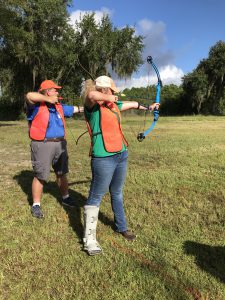
4-H Volunteers learn and practice the archery pre-shot routine so they can teach it to their youth. Photo: Julie P. Dillard
Ready to Lead
Sixteen 4-H volunteers joined ranks with one of Florida 4-H’s largest projects by earning their Level One Shooting Sports Instructor certification September 8. Training participants included 4-H volunteers and UF/IFAS Extension staff from Escambia, Holmes, Jefferson, Marion, Wakulla, Walton, Union and Alachua counties. What sets 4-H instructor training apart from other shooting sports trainings is the focus on youth life skills and positive youth development as opposed to focusing only on skill mastery.
About Florida 4-H Shooting Sports
The 4-H Shooting Sports Program teaches young people safe and responsible use of firearms, principles of archery and hunting basics. Lifelong skill development is one of the main benefits of involvement in the 4-H Shooting Sports Program and applies to both youth and adults involved in the program. Specifically, the 4-H Shooting Sports Program is designed to:
- Provide youth proper training in the use of firearms, archery equipment, and other areas of shooting sports.
- Provide thorough instruction in shooting sports safety.
- Develop life skills such as self-confidence, personal discipline, responsibility, and sportsmanship
- Create an appreciation and understanding of natural resources and their wise use.
- Provide volunteer instructors safe and proper instructional techniques.
- Show volunteer leaders how to plan and manage 4-H Shooting Sports Clubs. (Culen et al, 2018).
Resources for Success
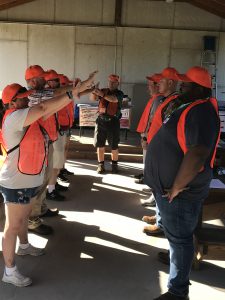
Establishing eye dominance is one of the first tasks of new member. Photo: Julie P. Dillard
It’s important to equip agents, volunteers and youth with the tools they need to succeed in the Florida 4-H Shooting . To assist you in organizing the county shooting sports program, here are some resources from the 4-H State Shooting Sports Committee and Environmental Sciences Action Team:
State Match Information, Rules and Risk Management
Youth Project Books
Getting Organized
To learn more about your county shooting sports program, contact your local 4-H agent.
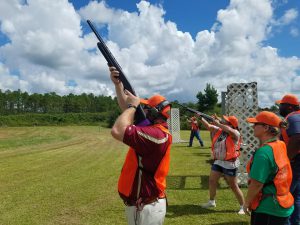
Wakulla 4-H Shooting Sports Club Leader, David Pienta, takes aim during shotgun instruction. Volunteers practice peer teaching to get ready to teach 4-H youth.
by Jena Gilmore | Sep 7, 2018

It’s that time of year again – Fair Season!
I can just smell the delicious scents of midway foods and see and hear the lights and squeals on carnival rides? But to most 4-H families, fairs go way beyond food and rides. During fair season, youth throughout the state dress up with pride in their 4-H green attire and prepare for what’s to come…fair exhibits!
Fair exhibits can range from artwork to plants to animals and finally, the epic fair booths. The most important thing for youth and adult exhibitors is knowing:
1. What counties are allowed to participate?
2. What and how many categories you may enter?
3. Exhibit requirements.
Here, we’ll cover preparing for fair booths and animal exhibits but you can find multiple links below for the state and local fairs with more information on exhibit entries and requirements.
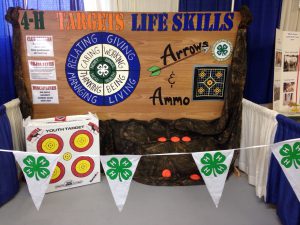
Fair booths are the highlight of displays at the fair
Organizations, like 4-H, use fair booths to visually communicate what we offer. Fair booths can be a great way to create a sense of Belonging in your club by having all members feel like they’re part of the 4-H Family! You want your communication to be effective, so prepare a checklist:
- Research the fair you want to enter – determine the deadline and registration requirements.
- Will you earn a booth premium? If so, figure out how much your club is willing to spend on supplies based on the premium could receive.
- Determine the size of your booth. Going out of booth boundaries can be a point deficit on the scorecard.
- Pick your booth theme and layout.
- Get commitments from members and parents to help with preparation, setup and breakdown. Delegate tasks so everyone feels like they have contributed.
Check out “Exhibits and Displays” below for a full checklist and more information!
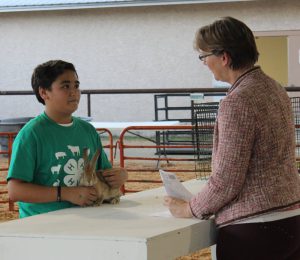
4-H’er talking to the judge of the Rabbit Show at Walton County Fair.
4-H Animal Exhibits
Rabbit, chicken, cattle, swine and goat exhibits are staples of fair week. Animal exhibits give many people the opportunity to see, learn about and interact with animals they don’t normally come across. For our 4-H youth, livestock exhibits and shows give youth the ability to gain Mastery through 4-H Project Learning. These highly experiential experiences teach youth a multitude of life skills. To get your animals fair ready:
- Research the fair’s deadlines and registration. Be sure to check deadlines for acquiring ownership and birth-dates of your animals.
- Check the vaccination and health certificate requirements for your animal and secure an appointment with a veterinarian to have this completed.
- Be on time or early to check-in. Sometimes, there is only one Agriculture Inspector and a long line of exhibitors. Some animals are required to do on-site blood testing, so be prepared with your paperwork and be patient.
- Determine if the fair provides the food and bedding and if exhibitors are required to care for their animals daily. This is not only important for the nutritional well-being of your animal but also for their emotional well-being.
Helpful Links:
Florida Panhandle Fair Opportunities:
- Escambia- Pensacola Interstate Fair (also open to Santa Rosa and Okaloosa counties)
- Okaloosa- Northwest Florida Fair (also open to Escambia and Okaloosa counties)
- Santa Rosa- Santa Rosa County Fair (open to all counties in the Northwest District)
- Walton- Walton County Fair (open to Walton and Okaloosa counties)
- Holmes- Holmes County 4-H Youth Fair
- Washington- Washington County Youth Fair (Beef and swine livestock shows are also open to Holmes and Bay counties)
- Jackson- Panhandle Youth Expo (also open to Walton, Washington, Calhoun, Holmes, Liberty, and Bay counties)
- Bay- Central Panhandle Fair
- Calhoun- no county fair, but eligible to participate in regional and state fairs
- Gulf- no county fair, but eligible to participate in regional and state fairs
- Liberty- no county fair, but eligible to participate in regional and state fairs
- Gadsden- West Florida Livestock Show and Sale (open to counties west of the Suwanee River)
- Franklin- no county fair, but eligible to participate in regional and state fairs
- Wakulla- no county fair, but eligible to participate in regional and state fairs.
- Leon- http://northfloridafair.com/
- Jefferson- no county fair, but eligible to participate in regional and state fairs
If you’re a fair veteran, 4-H alumni, or just someone interested in benefiting the youth of your community, contact your local UF/IFAS County Extension Office to find out how you can become a 4-H Volunteer and share your expertise!
by Julie Pigott Dillard | Aug 31, 2018
With so many extracurriculars available these days, parents and kids are overwhelmed with choices.
To choose the right one, know what to prioritize, says Heather Kent, associate director of the Florida 4-H youth development program, part of University of Florida’s Institute of Food and Agricultural Sciences Extension.
“The 4-H motto is ‘To make the best better.’ The research shows that kids are more likely to find success as adults when they feel confident and capable in the face of new challenges,” Kent said. “You want to find a program where kids can find their spark in a safe environment.”
So, when comparing extracurricular programs, keep this checklist in mind, Kent said.
- Does it help them do better in school?
Look for programs that complement a child’s day-to-day school work. “Each 4-H activity has an educational component to it,” Kent said. “Compared to their non-4-H peers, 4-H youth report better grades, higher levels of academic competence and an elevated level of engagement at school.”
- Does it teach them how to speak up?
Give your child a chance to express him or herself to others. “4-H alumni often say that the public speaking skills they learned in 4-H have helped them throughout their careers, no matter which field they are in,” Kent said.
- Does it include STEM?
“One of the goals of 4-H is prepare young people for the workforce, which means introducing them to STEM — science, technology, engineering and math — through hands-on projects in areas like horticulture, robotics and embryology,” Kent said.
- Does it broaden their horizons?
“The members of a 4-H club may not all go to the same school or live in the same neighborhood. Meeting people who have different backgrounds from yourself expands your worldview,” Kent said.
- Is it a good return on investment?
Some programs give you more bang for your buck. “Annual registration for 4-H is $20, and there are scholarships available. That gives youth access to a wide variety of projects and events—everything from aerospace to agriculture. If not for their 4-H membership, they might have to join several other organizations to get all the same opportunities,” Kent said.
- Does it help them explore their interests?
“Finding a passion teaches youth about delaying gratification and taking pride in their work. That’s something they take with them into their careers,” Kent said.
- Does it develop organization skills?
Choose activities that require kids to stay on top of things and plan ahead. “For a project to be successful, 4-H members know they need to stay organized. For instance, you can’t raise a prize-winning animal without a plan for how you are going to reach that goal,” Kent said.
- Is it open to everyone?
Consider whether the whole family can participate. “4-H is open to both boys and girls ages 5 through 18. There is also collegiate 4-H and adult volunteering opportunities. Unlike other programs, 4-H is something everyone in the household can be a part of,” Kent said.
- Does it introduce kids to mentors?
Having adult role models who aren’t one’s parents is an important part of youth development, Kent said. “Our trained volunteers and Extension agents form a support system for 4-H members. Knowing that another adult cares about you is a big confidence boost and helps kids feel comfortable trying new things.”
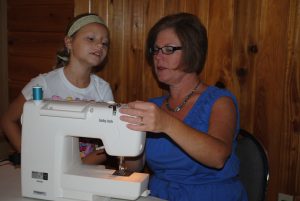
- Is it well established?
Learn about the history of the program. “4-H has been around for more than 100 years, and it’s been researched and developed through the U.S. Land Grant university system. In Florida, there are more than 200,000 youth in 4-H, and each of them benefits from being a part this longstanding, well known organization,” Kent said.
The mission of the University of Florida Institute of Food and Agricultural Sciences is to develop knowledge relevant to agricultural, human and natural resources and to make that knowledge available to sustain and enhance the quality of human life. With more than a dozen research facilities, 67 county Extension offices, and award-winning students and faculty in the UF College of Agricultural and Life Sciences, UF/IFAS works to bring science-based solutions to the state’s agricultural and natural resources industries, and all Florida residents. Visit the UF/IFAS web site at ifas.ufl.eduand follow us on social media at @UF_IFAS.
by Samantha Grenrock – Sam is a public relations specialist at UF/IFAS Communications. She loves animals, poetry and learning about science.
Shared with permission from the original author.





















